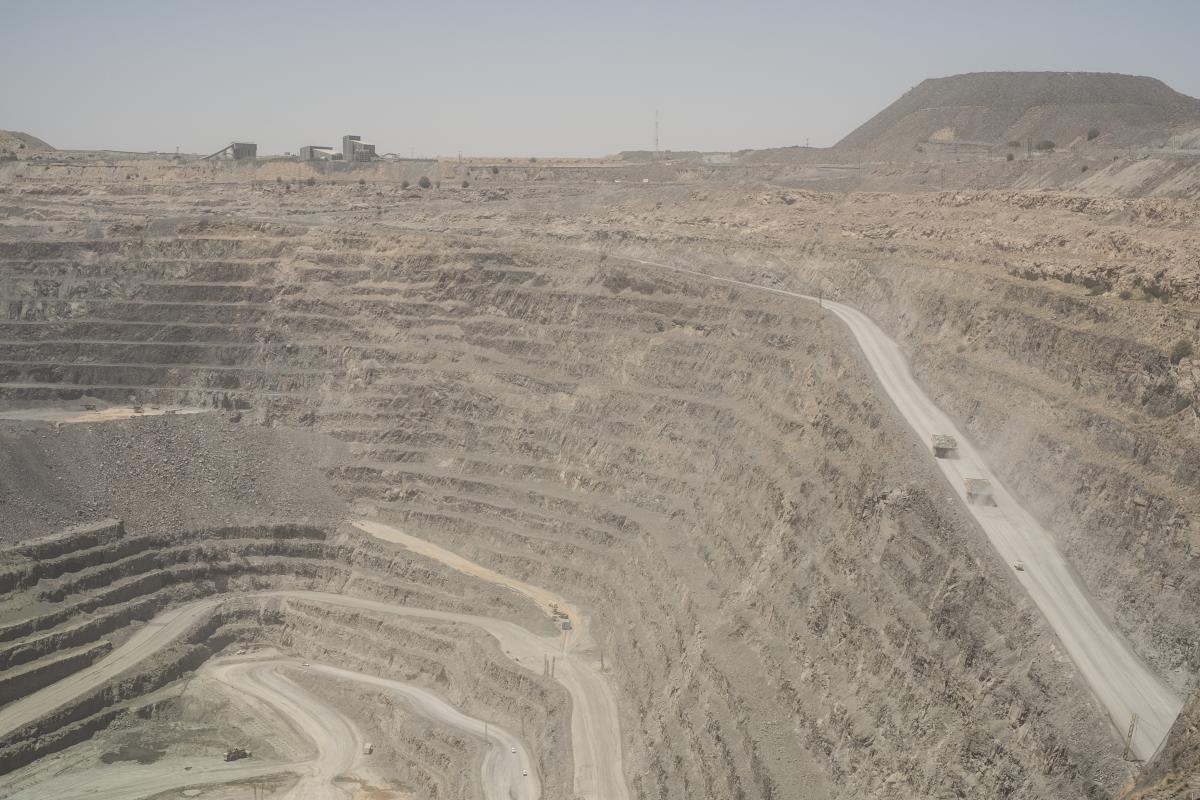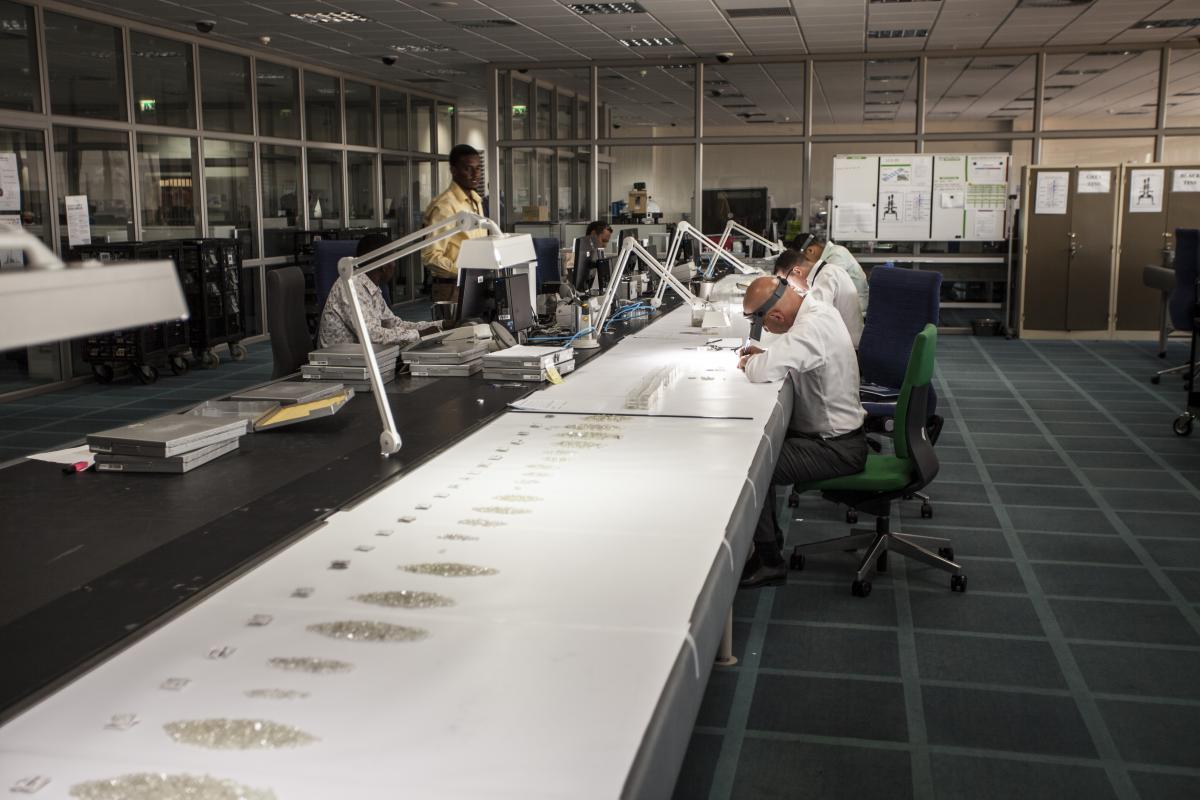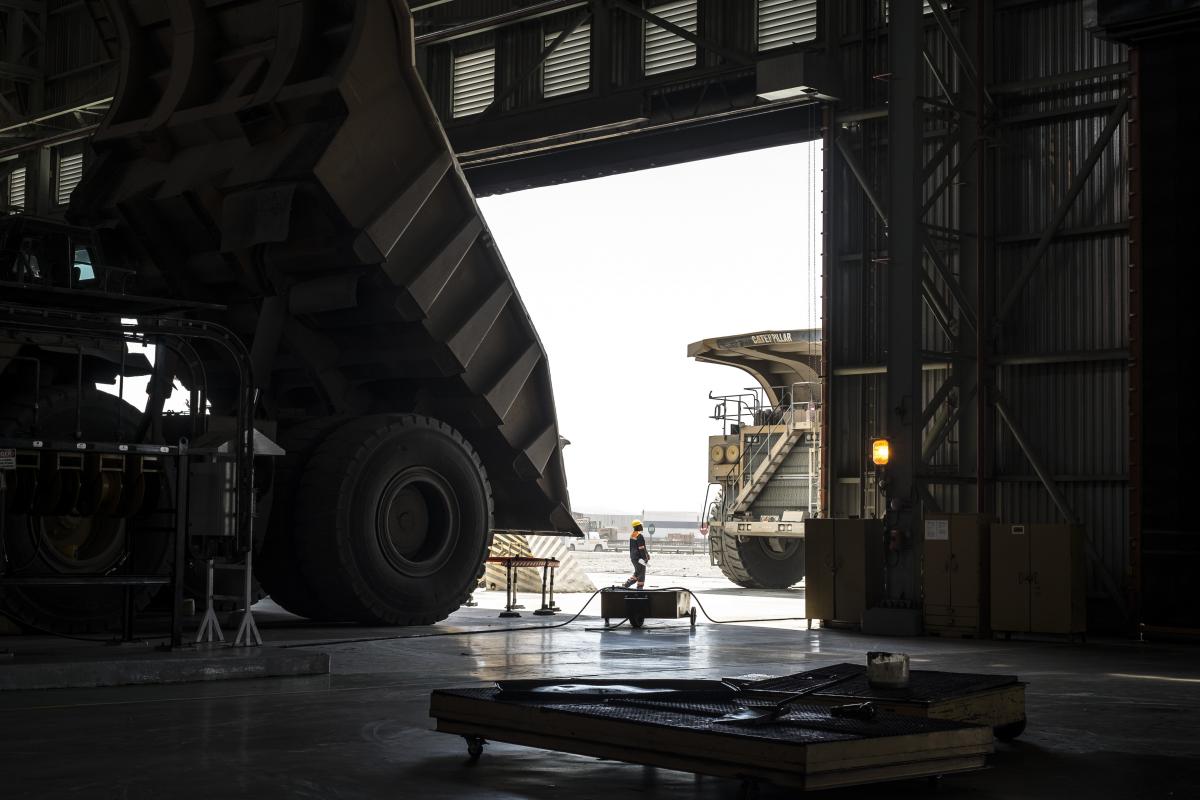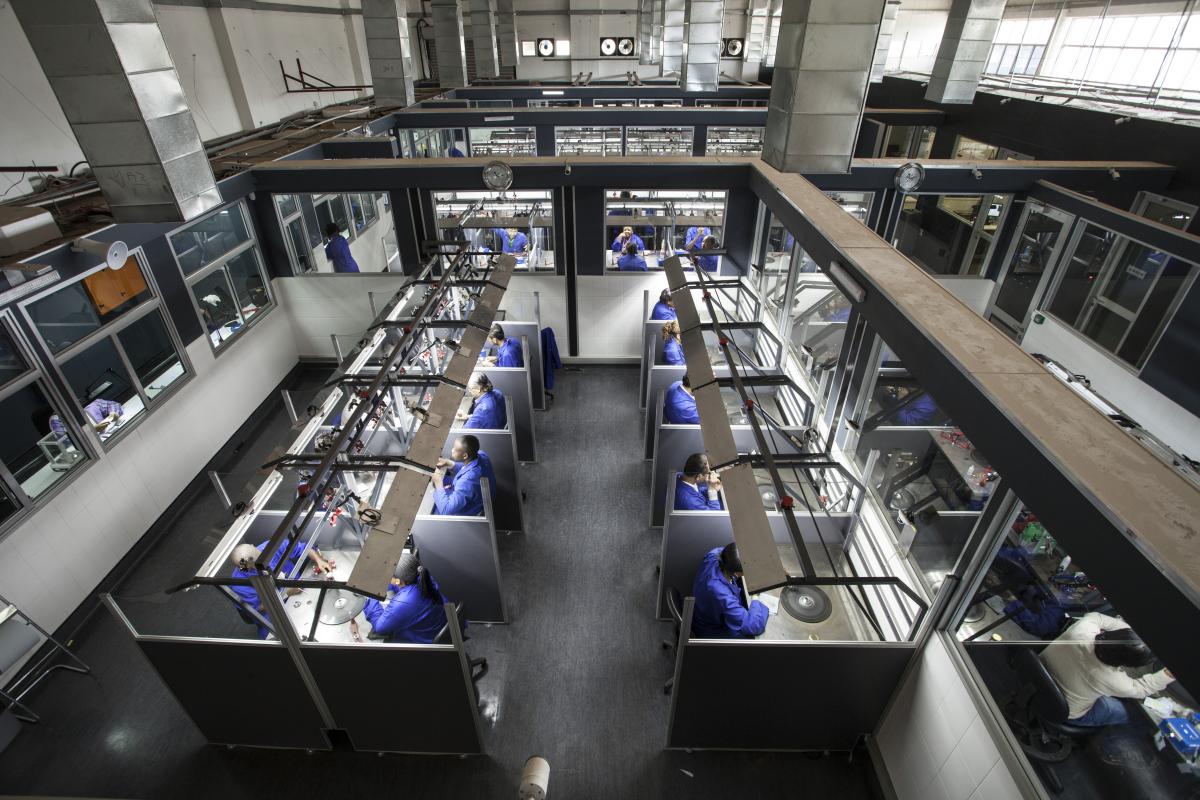Bringing Clarity to the Diamond Trade
The secrecy that cloaks the diamond industry serves to keep its operations secure, but also to give an aura of mystery to what are essentially rocks dug up out of the ground. Recent controversies, however, have sparked demands for greater transparency.
Cover Photo: Rough diamonds await inspection at De Beers’ Global Sightholder Sales facility in Gaborone, Botswana. (Photo: Pete Guest)
In late 2011, the most important man in the global diamond business landed in Botswana, the world’s biggest diamond-producing country, and couldn’t find a cab. Philippe Mellier had just taken over as CEO of the De Beers Group—arguably the most recognisable name in the trade—and although the country’s development has been inextricably linked to the diamond trade, it was clear that the benefits were not fully trickling down.
‘We had to stop a guy and ask him to take us to the city in his car,’ Mellier says. ‘The second or third guy said yes.’
Two years later, Mellier moved almost all of De Beers’ sorting and selling operations from London to Botswana’s capital Gaborone, part of a company-wide effort to demonstrate the value of the diamond business to a country that, even now, rarely catches sight of the finished product before it disappears into the secretive and opaque global supply chain.
Today, the diamond caravan comes here ten times a year for ‘Sights’—the opportunity to buy mixed boxes of rough stones. It has, Mellier acknowledges, been a major adjustment for his clients, who had for decades flown into London, with its luxury hotels, its high-class restaurants and, crucially, its airports. To get to Botswana from almost anywhere means a layover in Addis Ababa or Johannesburg, the latter entailing the added complexity of obtaining a South African transit visa.
‘I had my doubts,’ says Mellier, ‘but on day one, they were all here; it was Sight Nine, two years ago. They all came; we had a big party. They loved it.’

The main pit of the Jwaneng diamond mine, owned as a joint venture between De Beers and the government of Botswana. Jwaneng is the richest diamond mine in the world, producing about 11 million carats (2,200 kg) of diamonds a year. (Photo: Pete Guest)
The diamond trade is understandably opaque. Stones slip from mine to store along international supply chains that are tightly protected, the concentrated value and ease of concealment of a diamond making it an obvious target for theft and smuggling. At the same time, the intangible value of a diamond is in part due to the buyer’s feeling that the stone is special and rare; the more the process by which the stone is mined, cut and marketed is laid bare, the more the customer understands that they have been sold something far from unique.
You seem to enjoy a good story
Sign up to our infrequent mailing to get more stories directly to your mailbox.That lack of transparency has been abused at times—‘blood diamonds’ were a genuine phenomenon in West and Central Africa in the earlier part of the century—but the legitimate diamond business has transformed Botswana from a backwater to one of Africa’s most prosperous nations over the last 50 years. The country is dry, landlocked and almost entirely dependent on its mining exports: circumstances that have led other countries in the region into chaos and corruption.
Diamonds were discovered shortly after the country became independent in 1966, and De Beers, at that time owned by the Oppenheimer family, was there from the beginning. A quarter of the country’s economy and three-quarters of its export earnings come from the diamond trade.

The asset that started the boom is Jwaneng, the world’s richest diamond mine, a few hours outside of Gaborone. The central pit is a vast cauldron, 2 km (1.2 mi) across at its widest point and more than 400 m (1,300 ft) deep. Baboons patrol the upper reaches of the slopes, which are deep grey and swaddled in thick dust.
Down below, 200-tonne trucks shift the earth from the pit up to the waste pile: 1.2 trillion tonnes of rock and earth (a figure that will double in size over the next decade, according to Albert Milton, the mine’s managing director). Inside a vast hangar, truck parts are stacked up to be serviced, the chassis stripped back in a constant cycle of replacement. A full 13% of the mine’s operating budget is spent on tyres; its vehicles burn through 600 million tonnes of fuel a year.

At the base of the pit, four ‘pipes’ of kimberlite, the diamond-rich seams, are blasted out. Two gigantic white silos make up the processing unit, called the ‘Aquarium’—the Fully Automated Sort House, or Fish, and the Completely Automated Recovery Plant, or Carp. The two towers separate the rough diamonds from the ore that holds them. At every stage, security is tight. It is illegal for unlicensed individuals to buy or sell rough diamonds in Botswana, but the temptation remains. Workers receive a sizeable bonus for finding stones in the pit; random spot checks, including X-rays, provide a considerable disincentive for theft.
From Jwaneng, the stones are sent to De Beers’ new, high-tech sorting and ‘Sightholder Sales’ facility in Gaborone. The whole building is startlingly functional and utilitarian. Sitting behind high walls on a plot of dried-up scrubland on the road between the city centre and the airport, Sightholder Sales handles millions of dollars' worth of diamonds a day, although the actual number of stones is a closely guarded secret. Visitors pass through a maze of security airlocks and scanners; everyone in the building is under the constant gaze of CCTV.
Inside, rough diamonds pass through room after room of manual inspections. On workbenches, an international mix of experts sits hunched over loupes. The stones themselves lie in piles as they wait to be assessed, vast sums of money in potentia tossed almost casually on tables.
In one room, ‘special’ stones of more than ten carats are separated out, along with any diamonds of rare colour or clarity. Here, on a bank of computer terminals, gemologists spin 3D models of the stones, trying to find what the head of the unit, Paul Dooney, calls ‘polished outcomes’, the cuts to the stone that will produce the most valuable finished gem or gems. By the window, the most valuable of all sit in the southern African sun: each is estimated to be worth at least US$250,000 (€229,000).
Diamond producers face a dilemma—transparency and responsible sourcing help to clear their tarnished reputations, but the opacity of their operations contributes an aura of mystique that boosts the value of their wares.
Diamonds from the company’s mines in South Africa, Canada and Namibia are brought together and aggregated for sale in this facility. De Beers’ Sightholders, cutters who must qualify by being able to prove their capacity and willingness to buy significant quantities of diamonds on a regular basis, as well as pass a number of ethical filters, buy mixed boxes from small rooms, set along a grey, nondescript corridor on the ground floor. These 80 Sightholders purchase 90% of De Beers’ diamonds, and De Beers handles over a third of the world’s total rough diamond trade.
Botswana diamonds are sold separately, in their own Sight boxes. The government is intent on increasing the amount of skilled processing and manufacturing work and so put in place legislation to require that any rough diamonds mined in the country are also cut there. Unemployment in Botswana is relatively high, at around 18%. Amongst young people, that figure is higher still. Mining, while capital-intensive, does not create many jobs, and those it does create tend to be low-skilled and manual.
Capturing even a small proportion of the global diamond-cutting business from India, where 600,000 people work in the trade, could be transformational for Botswana. As Keith Jefferis, one of the country’s leading economists, says, the entire workforce of Botswana is less than 300,000 people. Just 1 or 2% of the Indian market would make a material difference to the employment rate. ‘Our small size makes quite a lot possible,’ he says. ‘We don’t need a high proportion of those jobs to come here to make a difference.’

KGK Diamond’s employees cut the final facets on diamonds inside its diamond cutting and polishing plant in Gaborone, Botswana. KGK Diamond acts as De Beers’ local sightholder. (Photo: Pete Guest)
The government’s policy of keeping diamond processing in the country has been a qualified success. At its peak in 2014 there were 21 factories and 3,700 people working in the industry. Since then, a slowdown in the Chinese economy has created a glut of stones in the cutting and polishing sector, as well as at retailers. This, in turn, has pushed prices down. In Botswana, two factories shut entirely and many others scaled back, cutting nearly 1,000 jobs in the process.
Only one company has bucked the trend. ‘It’s a long-term view, not a short-term view. We have been in business for over 100 years,’ says Sandeep Kothari, the managing director of KGK Diamonds, which opened its Gaborone factory in September 2015. When the current glut in the industry eases, he believes, KGK will benefit from being right next to the source.
The barn-like factory is comparable to those anywhere in the world, the production manager Ravindra Ahir says, as he demonstrates the ‘Galaxy Ultra’, an Israeli-made diamond-scanning machine whose workings are so secret that it has to be reset manually by a Galaxy engineer if it ever loses power. According to Ahir, there are only four such machines in existence.
De Beers’ marketing is known for seeding the concept of the diamond engagement ring in the American psyche in the 1930s and 1940s; today, it is an open secret that the company is trying to repeat the feat in Asia, where the tradition has still not taken hold outside of Japan.
Ahir oversees an eight-stage process from planning to finishing, with each diamond’s path through the factory written on a simple paper envelope. Workers shuttle back and forth to a bank of quality-control stations, where every cut is assessed and the stones are constantly weighed, from the moment that they arrive in orange Brinks bags to when they go into the office safe.
The company has leased a second, nearly identical factory in an adjacent unit, hoping to double capacity and increase employment. Already, the company has picked up a number of the cutters let go in the last round of sackings.
It may not be enough. There is a sense across the industry, from De Beers downwards, that the diamond trade needs to demonstrate its ability to contribute to Botswana beyond tax revenues. With that has come a new kind of transparency. De Beers hosted a conference with the international think tank Chatham House on the future of the economy in November, albeit one that was principally attended by those already involved in the business. ‘De Beers is disclosing a lot more than before. We were really seen as a black hole; I think that’s no longer the case,’ Mellier says.
Even so, there are limits to how far that disclosure is likely to go, as the company fights to preserve the value and perception of scarcity of diamonds.
‘I normally call them a bunch of crooks, because they are selling stones,’ one senior government official says, his tone only half-joking. ‘This is something they created, so they have to guard their secrets very closely.’

